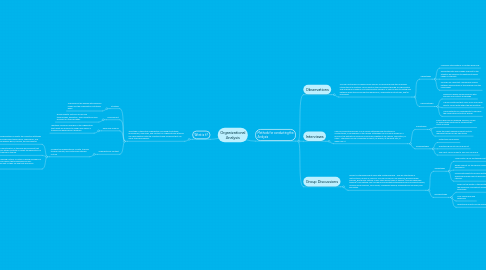
1. What is it?
1.1. The study of the entire organization including its strategy, environment, resources, and context. An organizational analysis can help identify potential constraints and problems that can derail training programs.
1.1.1. Strategy
1.1.1.1. Training must be aligned with business needs and the organization's strategic goals
1.1.2. Environment
1.1.2.1. Environmental factors such as new technologies, legislation, and competitors have an effect on training needs.
1.1.3. Resource Analysis
1.1.3.1. Identifies resources available in the organization that might be required to design and deliver a training and development program.
1.1.4. Organizational Context
1.1.4.1. Includes the organizational climate, training transfer climate, and continuous learning culture
1.1.4.1.1. Organizational Climate: the collective attitudes of employees toward work, supervision, and companies goals, policies, and procedures
1.1.4.1.2. Characteristics in the work environment that can either facilitate or inhibit the application of training on the job.
1.1.4.1.3. Continuous learning culture: a culture in which members of an organization believe that knowledge and skill acquisition are part of their job and that learning is important.
2. Methods for conducting the Analysis
2.1. Observations
2.1.1. Can be functionally or behaviourally specific as observing new staff members interacting at a meeting; can be unstructured as walking through an organization and looking for evidence of communication barriers; or can be used to distinguish between effective and ineffective behaviours, organizational structures, and/or processes.
2.1.1.1. Advantages
2.1.1.1.1. Minimizes interruptions of routine work flow
2.1.1.1.2. Generates data and is highly relevant to the situation by response to identified training needs or interests
2.1.1.1.3. Provides for important comparison checks between assumptions of the observer and the respondent
2.1.1.2. Disadvantages
2.1.1.2.1. Requires a highly skilled observer with process and content knowledge
2.1.1.2.2. Carries limitations that come from only being able to collect data within the work setting
2.1.1.2.3. Holds potential for respondents to perceive the observation activity as spying
2.2. Interviews
2.2.1. Can be conducted formally or in a casual setting and be structured or unstructured, or somewhere in the middle. Attendees can include a sample of a group or the entirety of everyone concerned, whether it be a board, committee, or other. Interviews can be conducted in person, by phone, at the work site, or away from it.
2.2.1.1. Advantages
2.2.1.1.1. Does a good job of revealing feelings, causes of and possible solutions to problems the client is facing
2.2.1.1.2. Gives the client maximum opportunity to represent himself on his own terms.
2.2.1.2. Disadvantages
2.2.1.2.1. Often time-consuming
2.2.1.2.2. Quantifying results can be difficult
2.2.1.2.3. The client can be made to feel self-conscious
2.3. Group Discussions
2.3.1. Similar to interviewing but done with multiple people - may be structured or unstructured, formal or informal. Can be focused on job analysis, group problem analysis, group goal setting, or any other group tasks or themes (such as leadership training). This method may include group facilitating techniques such as brainstorming, nominal group process, force fields, consensus ranking, organizational mirroring, and simulation.
2.3.1.1. Advantages
2.3.1.1.1. View points can be synthesized on the spot
2.3.1.1.2. Builds support for the service response that is decided on
2.3.1.1.3. Helps participants to become better at analyzing problems and to become better listeners
2.3.1.2. Disadvantages
2.3.1.2.1. Relies on the ability of the facilitator to guide the discussion and extract information effectively
2.3.1.2.2. Time consuming and expensive
2.3.1.2.3. Quantifying results can be difficult
